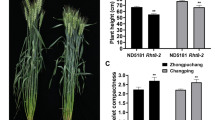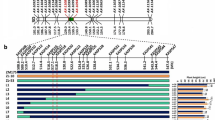Abstract
Reduction of plant height has played a significant role in improving wheat production and knowledge of dwarfing genes in Chinese wheat will be very important for develo** high yielding cultivars. Molecular markers were used to detect the presence of genes Rht-B1b (Rht1), Rht-D1b (Rht2) and Rht8 in 220 wheat genotypes from autumn-sown wheat regions in China. They include landmark landraces, leading cultivars and core parents involved in wheat breeding from the 1950s to the present. Results indicated that Rht-D1b and Rht8 dominate with frequencies of 45.5% and 46.8%, respectively, followed by Rht-B1b with a frequency of 24.5%. The frequencies of Rht-B1b and Rht-D1b increased, from 8.6 to 32.2% and 36.2 to 53.4%, respectively, whereas the frequency of Rht8 has remained constant over time, when compared with cultivars released before and after 1990. This indicates that both the Rht-B1b and Rht-D1b were successfully used in wheat production in Chinese environments. Our study shows that Rht-B1b and Rht-D1b can be used in the post-anthesis heat stressed environments. Rht-B1b in Chinese wheats is derived from two sources, viz., Norin 10 and the Italian introduction St2422/464 (Rht-B1b and Rht8). The identity of Rht-B1b in these two sources still needs to be confirmed. Suwon 86 carrying both Rht-B1b and Rht-D1b, and Chinese cultivars, Huixianhong and Yaobaomai, are the primary sources of Rht-D1b in Chinese wheats. It is likely that Rht-D1b in Youbaomai derives from an unknown introduction. Italian introductions such as Funo and Abbondanza, and Lovrin 10 with the 1B/1R translocation, and Chinese landraces are the three major sources of Rht8. This information will be very valuable for wheat breeding in China, and internationally.
Similar content being viewed by others
References
Ahmad M, Sorrells ME (2002) Distribution of microsatellite alleles linked to Rht8 dwarfing gene in wheat. Euphytica 123:235–240
Bai GH, Das MK, Carver BF, Xu XY, Krenzer EG (2004) Covariation for microsatellite alleles associated with Rht8 and coleoptile length in winter wheat. Crop Sci 44:1187–1194
Bassam BJ, Caetano-Anolles G, Gresshoff PM (1991) Fast and sensitive silver staining of DNA in polyacrylamide gels. Anal Biochem 196:80–83
Börner A, Worland AJ, Plaschke J, Schumann E, Law CN (1993) Pleiotrophic effects of genes for reduced (Rht) and day-length insensitivity (Ppd) on yield and its components for wheat grown in middle Europe. Plant Breeding 111:204–216
Botwright TL, Rebetzke GL, Condon AG, Richards RA (2005) Influence of the gibberellin-sensitive Rht8 dwarfing gene on leaf epidermal cell dimensions and early vigor in wheat (Triticum aestivum L.). Ann Bot 95:631–639
Bryan GJ, Collins AJ, Stephenson P, Orry A, Smith JB, Gale MD (1997) Isolation and characterization of microsatellites from hexaploid bread wheat. Theor Appl Genet 94: 557–563
Ellis MH, Spielmeyer W, Gale KR, Rebetzke GJ, Richards RA (2002) “Perfect” markers for the Rht-B1b and Rht-D1b dwarfing genes in wheat. Theor Appl Genet 105:1038– 1042
Evans LT (1998) Feeding the Ten Billion. Plant and Population Growth. Cambridge University Press, Cambridge, UK
Flintham E, Borner A, Worland A, Gale M (1997) Optimizing wheat grain yield effects of Rht (gibberellin-insensitive) dwarfing genes. J Agric Sci Camb 128:11–25
Gale MD, Youssefian S (1985) Dwarfing genes in wheat. In: GE Russed (ed), Progress in Plant Breeding Vol 1, Butterworths, London, pp. 1–35
Ganeva G, Korzun V, Landjeva S, Tsenov N, Atanasova M (2005) Identification, distribution and effects on agronomic traits of the semi-dwarfing Rht alleles in Bulgarian common wheat cultivars. Euphytica 145:305–315
Guo BH, Song CH, Jia JZ (1997) Identification and distribution of Rht1 and Rht2 genes in Chinese wheats. Scientia Agric Sin 30:56–60
He ZH, Rajaram S, **n ZY, Huang GZ (eds.) (2001) A History of Wheat Breeding in China. Mexico, D.F.: CIMMYT
Jia JZ, Ding SK, Li YH, Zhang H (1992) Studies of main dwarf genes and dwarf resources on Chinese wheat. Scientia Agric Sin 25:1–5
Korzun V, Röder MS, Ganal MW, Worland AZ, Law CN (1998)Genetic analysis of the dwarfing gene (Rht8) in wheat. Part I. molecular map** of Rht8 on the short arm of chromosome 2D of bread wheat (Triticum aestivum L.). Theor Appl Genet 96:1104–1109
Liu Y, Liu DC, Zhang HY, Wang J, Sun JZ, Guo XL, Zhang AM (2005) Allelic variation, sequence determination and microsatellite screening at the XGWM261 locus in Chinese hexaploid wheat (Triticum aestivum) varieties. Euphytica 145:103–112
McIntosh RA, Hart GE, Gale MD (1995) Catalogue of gene symbols for wheat. In: Li ZS, **n ZY (eds.), Proc of 8th Int Wheat Genet. Symp, pp 1333–1500. China Agricultural Scientech Press, Bei**g
Peng JR, Richards DE, Hartley NH, Murphy GP, Devos KM, Flintham JE, Beales J, Fish LJ, Worland AJ, Pelica F, Sudhakar D, Christou P, Snape JW, Gale MD, Harberd NP (1999) “Green revolution” genes encode mutant gibberellin response modulators. Nature 400:256– 261
Sambrook J, Fritsch EF, Maniatis T (1989) Molecular Cloning: a Laboratory Manual. Cold Spring Harbour Laboratory Press, Cold Spring Harbour, New York
Worland AJ (1986) Gibberellic acid insensitive dwarfing genes in southern European wheats. Euphytica 35:857– 866
Worland AJ, Law CN (1985) An effect of temperature on the fertility of wheats containing the dwarfing genes Rht1, Rht2, and Rht3. Annual Report, Plant Breeding Institute, Cambridge, 1984, pp. 69–71
Worland AJ, Sayers EJ, Korzun V (2001) Allelic variation at the dwarfing gene Rht8 locus and its significance in international breeding programmes. Euphytica 119:155– 159
Worland AJ, Korzum V, Röder MS, Ganal MW, Law CN (1998) Genetic analysis of the dwarfing gene (Rht8) in wheat. Part II. the distribution and adaptive significance of allelic variants at Rht8 locus of wheat as revealed by microsatellite screening. Theor Appl Genet 96:1110–1120
Zhou Y, He HZ, Zhang GS, **a LQ, Chen XM, Zhang LP, Chen F (2003) Identification of dwarfing gene Rht8 in Chinese wheat cultivars using microsatellite markers. Acta Agron Sin 29:810–814
Zhuang QS (ed) (2003) Chinese Wheat Improvement and Pedigree Analysis. Chinese Agricultural Press. Bei**g
Author information
Authors and Affiliations
Corresponding author
Rights and permissions
About this article
Cite this article
Zhang, X., Yang, S., Zhou, Y. et al. Distribution of the Rht-B1b, Rht-D1b and Rht8 reduced height genes in autumn-sown Chinese wheats detected by molecular markers. Euphytica 152, 109–116 (2006). https://doi.org/10.1007/s10681-006-9184-6
Received:
Accepted:
Published:
Issue Date:
DOI: https://doi.org/10.1007/s10681-006-9184-6




